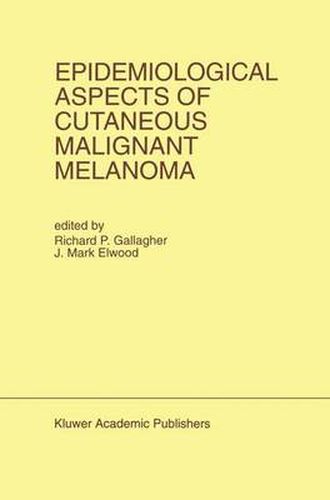Readings Newsletter
Become a Readings Member to make your shopping experience even easier.
Sign in or sign up for free!
You’re not far away from qualifying for FREE standard shipping within Australia
You’ve qualified for FREE standard shipping within Australia
The cart is loading…






Significant progress has been made in recent years in understanding the origins of cutaneous maligant melanoma. Knowledge of the relationship between solar radiation and melanoma has changed and it now appears that both the character and timing of exposure may be more important than total cumulative dose in accounting for risk. The melanoma-sunlight model may prove an instructive heuristic exercise for environmental epidemiology, as we currently tend to restrict ourselves to a search for uniform total dose-response relationships between cancers and suspected environmental carcinogens. The study of the relationship between acquired melanocytic nevi and melanoma has led to useful new information about predictors of melanoma risk and, in addition, has opened up new perspectives on the development of nevi in children. Definition of the factors for nevus development in children may lead to the possibility of primary prevention programmes for melanoma in younger generations of children. Recent new evidence suggests that certain occupational groups may be at elevated risk of melanoma. A great deal of work is going into the study of ways of screening high-risk populations in order to detect melanoma at its earliest stages when current treatment protocols are most effective. The visibility of lesions on the skin challenges classical definitions of early detection and screening in epidemiology.
$9.00 standard shipping within Australia
FREE standard shipping within Australia for orders over $100.00
Express & International shipping calculated at checkout
Significant progress has been made in recent years in understanding the origins of cutaneous maligant melanoma. Knowledge of the relationship between solar radiation and melanoma has changed and it now appears that both the character and timing of exposure may be more important than total cumulative dose in accounting for risk. The melanoma-sunlight model may prove an instructive heuristic exercise for environmental epidemiology, as we currently tend to restrict ourselves to a search for uniform total dose-response relationships between cancers and suspected environmental carcinogens. The study of the relationship between acquired melanocytic nevi and melanoma has led to useful new information about predictors of melanoma risk and, in addition, has opened up new perspectives on the development of nevi in children. Definition of the factors for nevus development in children may lead to the possibility of primary prevention programmes for melanoma in younger generations of children. Recent new evidence suggests that certain occupational groups may be at elevated risk of melanoma. A great deal of work is going into the study of ways of screening high-risk populations in order to detect melanoma at its earliest stages when current treatment protocols are most effective. The visibility of lesions on the skin challenges classical definitions of early detection and screening in epidemiology.